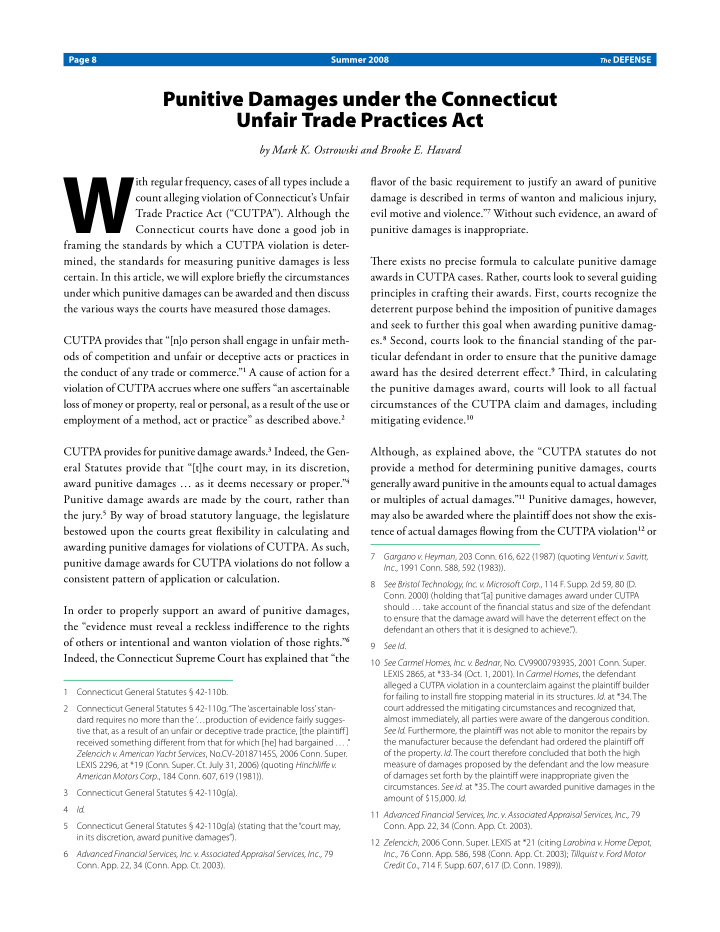



ticular defendant in order to ensure that the punitive damage loss of money or property, real or personal, as a result of the use or Indeed, the Connecticut Supreme Court has explained that “the awards in CUTPA cases. Rather, courts look to several guiding the “evidence must reveal a reckless indifgerence to the rights In order to properly support an award of punitive damages, consistent pattern of application or calculation. punitive damage awards for CUTPA violations do not follow a awarding punitive damages for violations of CUTPA. As such, bestowed upon the courts great fmexibility in calculating and principles in crafting their awards. First, courts recognize the Punitive damage awards are made by the court, rather than deterrent purpose behind the imposition of punitive damages eral Statutes provide that “[t]he court may, in its discretion, damage is described in terms of wanton and malicious injury, the punitive damages award, courts will look to all factual violation of CUTPA accrues where one sufgers “an ascertainable punitive damages is inappropriate. circumstances of the CUTPA claim and damages, including ods of competition and unfair or deceptive acts or practices in Although, as explained above, the “CUTPA statutes do not the various ways the courts have measured those damages. under which punitive damages can be awarded and then discuss certain. In this article, we will explore briefmy the circumstances mined, the standards for measuring punitive damages is less provide a method for determining punitive damages, courts Connecticut courts have done a good job in Trade Practice Act (“CUTPA”). Although the count alleging violation of Connecticut’s Unfair ith regular frequency, cases of all types include a generally award punitive in the amounts equal to actual damages fmavor of the basic requirement to justify an award of punitive Tiere exists no precise formula to calculate punitive damage Page 8 Summer 2008 The DEFENSE Punitive Damages under the Connecticut Unfair Trade Practices Act by Mark K. Ostrowski and Brooke E. Havard W evil motive and violence.” 7 Without such evidence, an award of framing the standards by which a CUTPA violation is deter - and seek to further this goal when awarding punitive damag - CUTPA provides that “[n]o person shall engage in unfair meth - es. 8 Second, courts look to the fjnancial standing of the par - the conduct of any trade or commerce.” 1 A cause of action for a award has the desired deterrent efgect. 9 Tiird, in calculating employment of a method, act or practice” as described above. 2 mitigating evidence. 10 CUTPA provides for punitive damage awards. 3 Indeed, the Gen - award punitive damages … as it deems necessary or proper.” 4 or multiples of actual damages.” 11 Punitive damages, however, the jury. 5 By way of broad statutory language, the legislature may also be awarded where the plaintifg does not show the exis - tence of actual damages fmowing from the CUTPA violation 12 or 7 Gargano v. Heyman , 203 Conn. 616, 622 (1987) (quoting Venturi v. Savitt, Inc ., 1991 Conn. 588, 592 (1983)). 8 See Bristol Technology, Inc. v. Microsoft Corp ., 114 F. Supp. 2d 59, 80 (D. Conn. 2000) (holding that “[a] punitive damages award under CUTPA should … take account of the fjnancial status and size of the defendant to ensure that the damage award will have the deterrent efgect on the defendant an others that it is designed to achieve.”). of others or intentional and wanton violation of those rights.” 6 9 See Id . 10 See Carmel Homes, Inc. v. Bednar , No. CV990079393S, 2001 Conn. Super. LEXIS 2865, at *33-34 (Oct. 1, 2001). In Carmel Homes , the defendant alleged a CUTPA violation in a counterclaim against the plaintifg builder 1 Connecticut General Statutes § 42-110b. for failing to install fjre stopping material in its structures. Id. at *34. The 2 Connecticut General Statutes § 42-110g. “The ‘ascertainable loss’ stan- court addressed the mitigating circumstances and recognized that, almost immediately, all parties were aware of the dangerous condition. dard requires no more than the ‘…production of evidence fairly sugges- See Id. Furthermore, the plaintifg was not able to monitor the repairs by tive that, as a result of an unfair or deceptive trade practice, [the plaintifg] received something difgerent from that for which [he] had bargained … .” the manufacturer because the defendant had ordered the plaintifg ofg of the property. Id. The court therefore concluded that both the high Zelencich v. American Yacht Services , No.CV-20187145S, 2006 Conn. Super. LEXIS 2296, at *19 (Conn. Super. Ct. July 31, 2006) (quoting Hinchlifge v. measure of damages proposed by the defendant and the low measure of damages set forth by the plaintifg were inappropriate given the American Motors Corp ., 184 Conn. 607, 619 (1981)). circumstances. See id. at *35. The court awarded punitive damages in the 3 Connecticut General Statutes § 42-110g(a). amount of $15,000. Id. 4 Id. 11 Advanced Financial Services, Inc. v. Associated Appraisal Services, Inc ., 79 5 Connecticut General Statutes § 42-110g(a) (stating that the “court may, Conn. App. 22, 34 (Conn. App. Ct. 2003). in its discretion, award punitive damages”). 12 Zelencich , 2006 Conn. Super. LEXIS at *21 (citing Larobina v. Home Depot, 6 Advanced Financial Services, Inc. v. Associated Appraisal Services, Inc ., 79 Inc ., 76 Conn. App. 586, 598 (Conn. App. Ct. 2003); Tillquist v. Ford Motor Conn. App. 22, 34 (Conn. App. Ct. 2003). Credit Co ., 714 F. Supp. 607, 617 (D. Conn. 1989)).
Recommend
More recommend